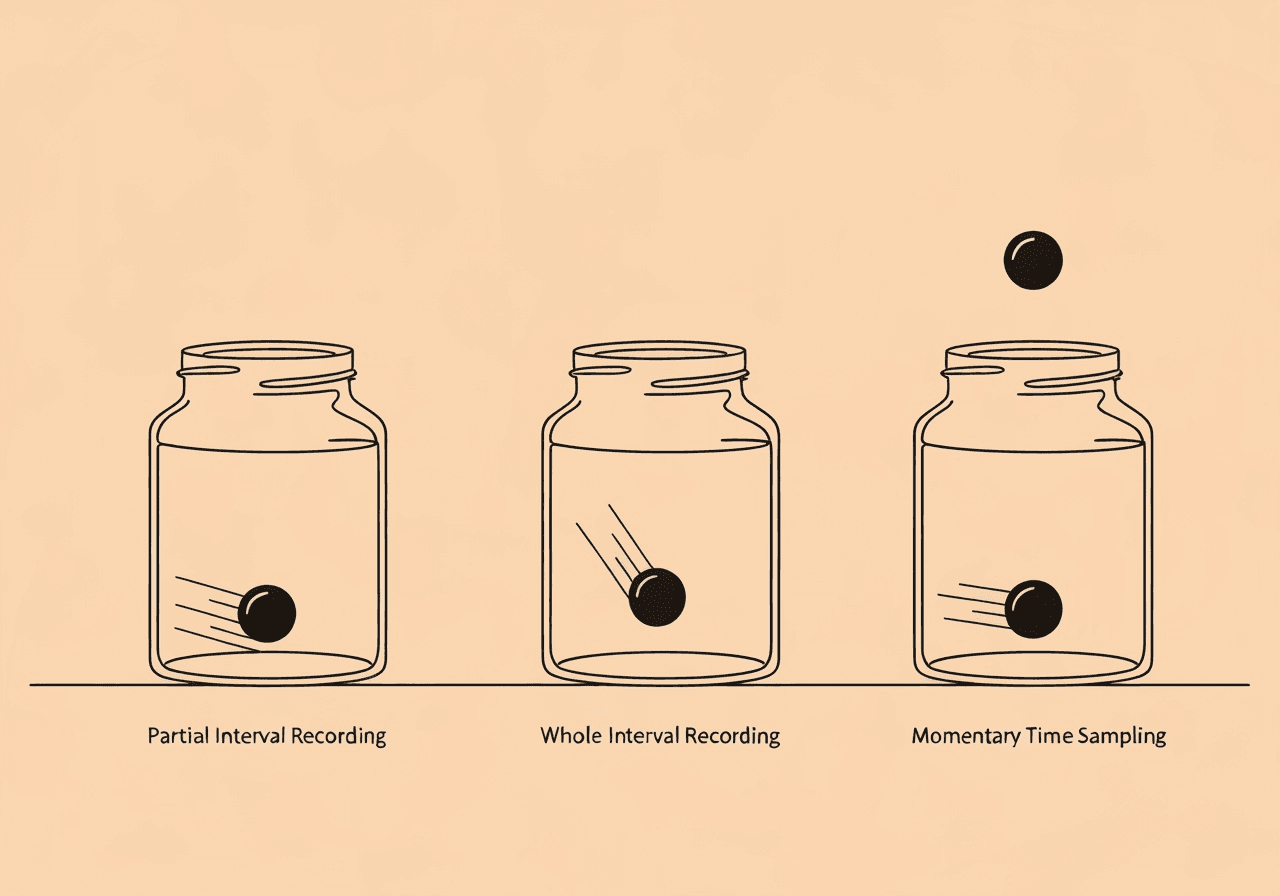ABA Principles and Techniques Every RBT Must Know [2025]
![ABA Principles and Techniques Every RBT Must Know [2025] Minimal line illustration of hands organizing geometric shapes, representing ABA principles and techniques.](/_next/image?url=https%3A%2F%2Fl0qdfezqmw69fxn5.public.blob.vercel-storage.com%2Fresources%2Faba-principles-techniques-guide-1756047137875.png&w=3840&q=75)
Are you wondering what makes ABA therapy actually work? Understanding ABA principles and techniques is crucial for RBTs and BCBAs who want to deliver interventions that create real change. Whether you're cramming for your RBT exam or training new team members, these foundational concepts will transform how you practice—and boost your client outcomes.
This guide breaks down the essential core ABA principles, proven techniques, and real-world applications every behavior professional needs in their toolkit.
Core ABA Principles Every RBT Should Master
Here's the thing: Applied Behavior Analysis runs on three fundamental principles that guide every therapeutic intervention you'll ever implement.
First up is behavior modification—the heart of everything we do. It's all about changing socially significant behaviors that might be getting in the way of learning or social interaction. You'll need to assess behaviors across different environments to really understand what's triggering them and what consequences are maintaining them.
Positive reinforcement ABA is your second core principle. It involves delivering immediate rewards right after desired behaviors to make them more likely to happen again. But here's what matters most: identifying what actually reinforces each individual client. What works like magic for one kid might be completely useless for another.
Data collection rounds out the essential trio. We're talking systematic measurement and documentation of behavioral changes over time. This keeps your interventions grounded in real evidence rather than gut feelings or wishful thinking.
The Seven Dimensions: ABA's Scientific Framework
The seven dimensions of ABA established in 1968—applied, behavioral, analytic, technological, conceptually systematic, effective, and generality—still guide evidence-based practice today. Think of them as your scientific compass.
Applied techniques within this framework include reinforcement (rewards for positive behaviors), extinction (removing rewards for undesired behaviors), and prompting with fading (gradually reducing assistance as independence develops).
Generalization ensures skills actually transfer across settings, people, and situations. Because what good is a skill that only works in the therapy room? Shaping breaks complex behaviors into bite-sized pieces, while chaining teaches multi-step tasks one link at a time.
But how do these dimensions play out in your day-to-day work? They provide the scientific backbone that separates ABA from other therapeutic approaches—and they're what make our interventions actually effective.
Popular ABA Techniques for RBT Implementation
Discrete Trial Training (DTT)
DTT represents one of the most structured ABA applications out there. You're breaking complex skills into smaller, manageable tasks through highly organized teaching sessions.
DTT Implementation Steps:
- Set up your teaching materials where the learner can clearly see them
- Wait for readiness and attention
- Give your antecedent instruction (SD)
- Use scripted prompts when needed
- Allow response time
- Deliver appropriate consequences
- Include that intertrial interval for data collection
Natural Environment Teaching (NET)
NET flips the script by taking learning into everyday settings. Instead of DTT's structured approach, NET operates through flexible, play-based interactions in natural settings.
NET works particularly well for skill generalization—helping clients apply what they've learned in real-life situations. Most successful programs combine DTT and NET approaches. Use DTT for building foundational skills, then NET for real-world application.
Positive Behavior Support Strategies
Antecedent-based interventions modify environmental factors before challenging behaviors even occur. We're talking environmental modifications, routine changes, and visual supports that prevent problems rather than just react to them.
Behavior contracts promote accountability through clear expectations and reward systems. They work especially well with older children who understand reinforcement concepts and can participate in the process.
Evidence-Based Practice in ABA
Modern ABA emphasizes evidence-based practice (EBP), which integrates three key components: best available research evidence, clinical expertise, and client values. This framework ensures you're making transparent decisions about treatment approaches.
EBP promotes collaborative decision-making that keeps client goals, values, and preferences at the center of intervention planning. The result? More effective and meaningful outcomes because you're tailoring interventions to individual needs rather than using cookie-cutter approaches.
The dissemination of behavior analysis research has expanded significantly, with studies now reaching broader audiences through news media, policy documents, and social platforms—increasing ABA's real-world impact beyond clinical settings.
Real-World ABA Applications
Successful ABA programs tackle multiple skill domains simultaneously. Today's applications focus on building communication skills, social interaction abilities, daily living routines, and emotional regulation while addressing interfering behaviors.
As an RBT, you'll work under BCBA supervision to implement treatment plans, collect data, and make real-time adjustments. This collaborative approach ensures you're implementing techniques correctly while maintaining program integrity.
Ready to streamline your ABA session documentation while applying these principles effectively? The right tools can make all the difference.
FAQs About ABA Principles and Techniques
What are the most important ABA techniques for new RBTs? New RBTs should master DTT, NET, reinforcement strategies, and data collection first. These form the foundation for most behavioral interventions and are essential for RBT certification success. Everything else builds from here.
How do DTT and NET actually work together? DTT builds foundational skills in structured settings, while NET helps generalize those skills to natural environments. Most effective programs use both approaches as partners rather than choosing one over the other. It's like learning to ride a bike in the driveway, then taking it to the neighborhood.
What makes positive reinforcement ABA different from punishment-based approaches? Positive reinforcement focuses on adding desirable consequences to increase behaviors, creating more sustainable and ethical behavior change than punishment-based methods. It's also what modern compassionate care approaches in ABA emphasize—building people up rather than breaking them down.
How often should ABA techniques be modified? Techniques should be adjusted based on data collection and client progress. Regular team meetings and data review ensure interventions remain effective and responsive to changing needs—typically weekly or bi-weekly for most programs. If something isn't working, don't wait months to change it.
What role do core ABA principles play in session documentation? Core ABA principles guide data collection, intervention selection, and progress measurement, which are essential for compliant session notes and insurance reporting. They're the foundation that supports everything you document.
Mastering ABA Principles for Professional Success
Understanding ABA principles and techniques creates the foundation for effective behavioral intervention. Whether you're preparing for certification or expanding your clinical skills, these evidence-based approaches will enhance your professional practice and improve client outcomes.
Popular in Behavior Analysis Concepts
- 1
ABA Prompting Hierarchy & Prompt Fading: RBT How-To Guide with Examples
7837 min read - 2
DRA vs DRI vs DRO vs DRL: The Clear RBT Comparison Guide
6589 min read - 3
Functional Behavior Assessment ABA: Complete 2025 Guide [Step-by-Step]
6446 min read - 4
Partial Interval vs Whole Interval vs MTS: ABA Guide
6316 min read - 5
Master IOA Formulas and Methods for Data Integrity
5158 min read
Popular in Behavior Analysis Concepts
- 1
ABA Prompting Hierarchy & Prompt Fading: RBT How-To Guide with Examples
7837 min read - 2
DRA vs DRI vs DRO vs DRL: The Clear RBT Comparison Guide
6589 min read - 3
Functional Behavior Assessment ABA: Complete 2025 Guide [Step-by-Step]
6446 min read - 4
Partial Interval vs Whole Interval vs MTS: ABA Guide
6316 min read - 5
Master IOA Formulas and Methods for Data Integrity
5158 min read
Related Resources
Explore more helpful content on similar topics

Master ABA Stimulus Equivalence: Derived Relations Guide
Master ABA stimulus equivalence and derived stimulus relations. Explore reflexivity, symmetry, transitivity, and equivalence classes to boost your ABA practice and promote effective generalization in behavior analysis.

Partial Interval vs Whole Interval vs MTS: ABA Guide
Discover Partial Interval vs Whole Interval vs MTS in ABA: Explore definitions, pros, cons, biases like overestimation and underestimation, and a BCBA decision tree for choosing the best method to ensure accurate data collection and high IOA.
![Functional Behavior Assessment ABA: Complete 2025 Guide [Step-by-Step] Minimal line drawing of a person with a notepad examining abstract gears and puzzle shapes, evoking thoughtful analysis.](/_next/image?url=https%3A%2F%2Fl0qdfezqmw69fxn5.public.blob.vercel-storage.com%2Fresources%2Ffunctional-behavior-assessment-aba-guide-1757002691575.png&w=3840&q=75)
Functional Behavior Assessment ABA: Complete 2025 Guide [Step-by-Step]
Learn how functional behavior assessment ABA helps identify behavior causes and create effective treatment plans. Discover key FBA steps and documentation tips.